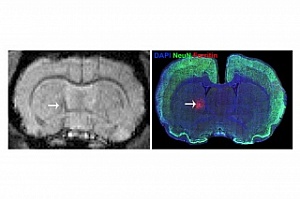TSU neuroscientists and colleagues from Belgium and the USA have created a non invasive tool to track the movement of young neurons. To do this, scientists mark new brain cells with a special marker that can be seen on MRT (magnetic resonance tomography). Viral vectors - inactivated viruses that can easily enter the cell, act as delivery couriers of markers. The new tool, created with the support of the Russian Science Foundation, will help to predict the dynamics of patient recovery and assess the pace of rehabilitation after stroke and traumatic brain injury.
- It is known that after a stroke, in special zones of neurogenesis, there is an active production of young neurons. They migrate to the affected area to replace the dead neurons, - explains Marina Khodanovich, head of the Laboratory of Neurobiology at the TSU Biological Institute. - But before there were methods to track these cells in a living brain, this could only be understood postmortem. To see how young neurons travel, we and colleagues from the University of Leuven (Belgium) - Irina Thiry and Veronique Daniels - designed special vectors based on lentiviruses and adenoassociated viruses. Genetic engineers extracted a pathogenic component from them and inserted a gene that increases the production of ferritin, and also a special genetic sequence (promoter), thanks to which the production of ferritin will increase only in young neurons. Young neurons store ferritin, and therefore iron, which makes them visible.
The researchers tested the new tool on rats. They simulated ischemic cerebral stroke in laboratory animals, introduced a genetic tag, and tracked the process of neurogenesis. The rats' brains were scanned on the most powerful high-field magnetic resonance imaging machine in Russia, designed for research on small laboratory animals.
- As part of the experiment, the condition of 40 stroke survivors was assessed, says Marina Khodanovich. During the month, each of them had several scans. On the MRT scans, we saw changes characteristic of iron accumulation. Then we examined sections of animal brains and identified cells that had accumulated ferritin. It turned out that the localization of changes in the MRT signal and the neurons that accumulated ferritin coincide well, and not only with young but also with adult neurons that are included in the neural network. This suggests that the first non invasive way to track new neurons using viral vectors is indeed effective.
According to the neurobiologist, this method cannot be used in humans, because an increase in ferritin content affects cell metabolism. But the new approach helps to understand and trace in animals how the brain recovers from stroke, injury, and other diseases. This knowledge will help create new therapies and predict brain recovery after severe disorders.
In the near future, scientists to analyze a large amount of information obtained during the experiment. This will make it possible not only to reveal new data on neurons but also to evaluate the functional characteristics of vectors, to choose the most effective and safe ones for changing the functions of neurons.
The new method makes it possible to monitor other cells of the nervous system that cannot yet be seen on MRT. For example, with ischemia, a glial scar appears around the focus - a kind of barrier that encloses the area in which the dead cells are located. Until a certain time, until the immune cells remove the "garbage" in the form of dead neurons, this scar is even useful, but later it interferes with the germination of axons (processes along which nerve impulses travel) and the restoration of the activity of the central nervous system.
- There is no way to non-invasively look at astrocytes - those cells that form a glial scar, but the use of viral vectors can solve this problem, - adds Marina Khodanovich. – After labels are delivered to astrocytes, it will be possible to see their behavior. In the future, it is possible to find a way to change their morphology in order to destroy the glial scar and accelerate the patient's recovery process. This is just one use case for vectors. The potential of the new instrument is much broader.
As part of further research, neuroscientists of TSU intend to obtain a whole series of important data to find out the functional characteristics of new neurons and how fully they are included in the work of the neural network.

